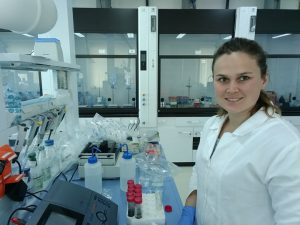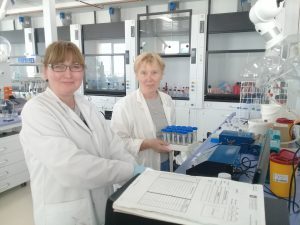Environmental Science & Technology Group hosts visiting researcher at NU

Andrea Domán is PhD candidate at the Surface Chemistry Group Department of Physical Chemistry and Materials Science, Faculty of Chemical Technology and Biotechnology, Budapest University of Technology and Economics, Hungary) led by Prof. Krisztina László http://www.fkt.bme.hu/~surf/?page_id=386).
Andrea has been staying for one month secondment at Nazarbayev University in April 2019, within the frame of NanoMed project. This project belongs to Horizon 2020 Marie Skłodowska-Curie Research and Innovation Staff Exchange program (MSCA-RISE-2016). Andrea is working under the surveillance of Prof. Vasileios Inglezakis, head of the Environmental Science & Technology Group (Chemical Engineering Department, Nazarbayev University).
The aim of NanoMed project (http://www.nanomed-project.eu/) is stimulate intersectoral and international collaboration within Europe and with an ICPC country, Kazakhstan, in the area of novel nanoporous and nanostructured adsorbents for the treatment of very serious health conditions associated with acute and chronic exposure to external radiation and uptake of heavy metals and radiation as a consequence of accidental, occupational or deliberate activities and events.
Environmental Science & Technology Group has extensive experience in the application of various porous materials e.g. zeolites as adsorbents, to remove harmful substances such as heavy metals or iodide from aqueous solutions. Surface Chemistry Group has outstanding knowledge in design, preparation and characterization of resorcinol-formaldehyde (RF) based carbon aerogels and its composites. The purpose of this cooperation is the investigation of the I – and Hg 2+ adsorption from aqueous solution on nitric acid treated resorcinol-formaldehyde carbon aerogel and graphene oxide-containing resorcinol-melamine-formaldehyde carbon aerogel and determining the adsorption kinetics and isotherms. The adsorption derived decrease in I – concentration of the solutions will be followed by UV-Vis spectrophotometer. In case of Hg 2+ adsorption, a mercury analyzer with a pyrolysis technique will be used to quantify the amount of mercury in the solution.
“We will analyse the possible structural changes of the carbon aerogels related to the chemisorption of the target ions with FTIR or other techniques. We would like to compare the adsorption performance of the two RF based carbon aerogels and also of the zeolites. Hopefully the results will bring us closer to the main goal of NanoMed project, to develop proper adsorbents for the treatment of serious health conditions,” told Andrea.

Gratitude letter to ESTg from Budapest University of Technology and Economics
Jun 1st, 2019
“This is my very first visit to Kazakstan, lasting for a month and getting to the end by 1 June. I came here as a senior secondee of the H2020 NanoMed project ( http://www.nanomed-project.eu/ ) from the Budapest University of Technology and Economics (BME) where I head of the Surface Chemistry Research Group. My visit follows the internship of my PhD student Ms.Andrea Domán, who worked here also for a month in April. Both of us were hosted by the Environmental Science and Technology Group (ESTg). Within the frame of this EU supported research project the main task of the BME team is to develop new materials for pollution control. Both Andrea and me were perfectly supported by our host, Prof. Vassilis J. Inglezakis and his group to have access to the outstanding analytical facilities of the Nazarbayev University to characterize those new materials.
Moreover, the one month period even allowed us to test our materials against model pollutants such as iodide and mercury. Based on the experience of the collaboration Vassilis and me decided to intensify our scientific cooperation.
I am very thankful to Vassilis and his group as well as all the people who helped us during our stay at Nazarbayev University.”
Prof. Krisztina László





